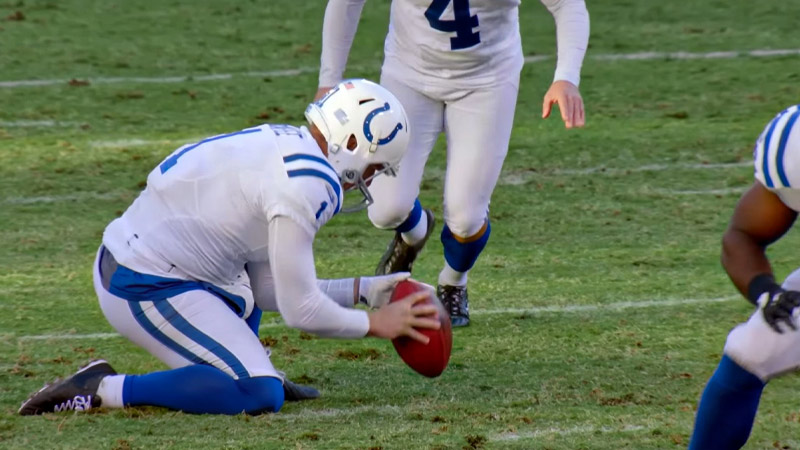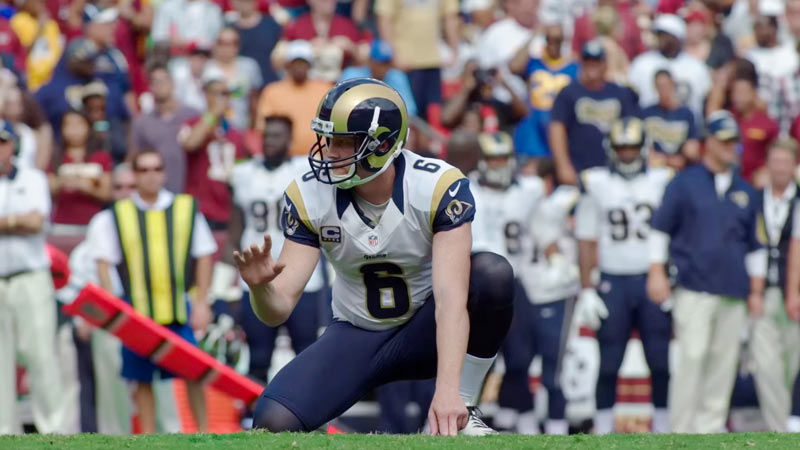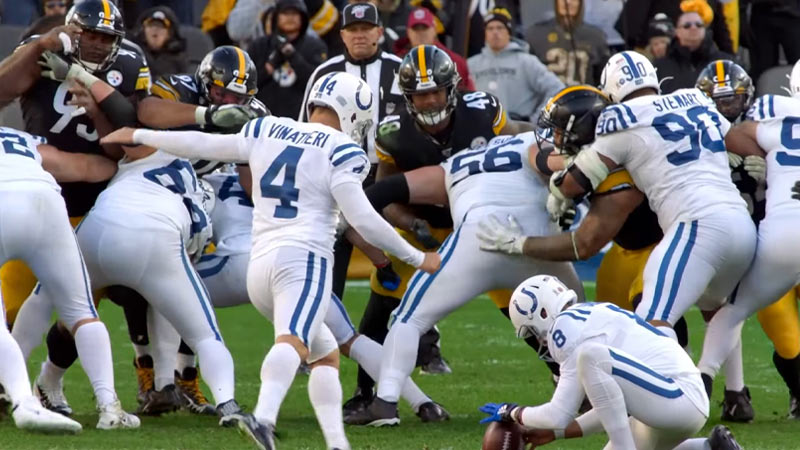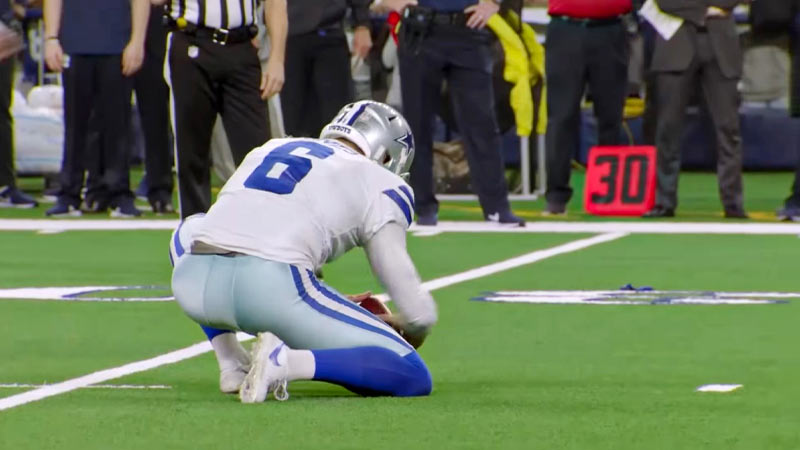In American football’s high-stakes world, the unsung heroes often make the difference between a win and a loss.
Among them is the holder, a specialized player responsible for a pivotal role in field goals and extra-point attempts.
While often overlooked, the holder’s precision and communication skills are the glue that holds the special teams unit together.
This blog post will delve into the nuanced responsibilities of the American football holder position, from snap to kick. We’ll explore their critical role in ensuring the ball is placed correctly, laced out, and ready for the kicker.
We’ll also discuss their positioning, communication with the kicker, and their ability to adapt to varying conditions on the field.
The holder’s role is key to appreciating the intricacies of the game and the impact they have on the scoreboard. Stay sharp.
The Anatomy of a Successful Hold in American Football
A successful hold in American football is crucial to a well-executed field goal or extra-point attempt. The anatomy of such a hold involves several key components.
Firstly, the holder receives the snap from the long snapper precisely, ensuring the ball’s placement on the ground is laced out, providing a clean surface for the kicker. The holder then swiftly places the ball, maintaining the ideal tilt and orientation.
Timing is critical, with the holder ensuring the ball is in place and stationary before the kicker’s approach. The holder must also be ready to adjust to a high or low snap.
Clear communication between the holder and the kicker is essential. The kicker relies on the holder’s setup and consistency for a successful kick.
A successful hold combines precise ball placement, timing, adaptability, and communication between the holder and kicker, resulting in a well-executed field goal or extra point.
Responsibilities of the Holder in American Football

The holder in American football plays a critical role in the success of field goals and extra-point attempts. Their responsibilities include:
Receiving the Snap
The holder receives the snap from the long snapper and must do so cleanly and accurately. This involves catching or fielding the snap and being prepared for potential variations in the snap’s trajectory.
Ball Placement
After receiving the snap, the holder must place the football on the ground with the laces out. This ensures that the kicker has a clean and smooth surface to strike the ball, which is crucial for accuracy.
Positioning
To facilitate a smooth kick, the holder must position the ball with the correct tilt, typically with the laces facing the goalpost. They must also orient the ball correctly, aligning it with the kicker’s preferred kicking spot.
Timing
Timing is crucial. The holder needs to place the ball and get it stationary quickly, ensuring that it’s in the right position for the kicker as they approach for the kick.
Adjustment
In case of a high or low snap, the holder must be prepared to adjust and still get the ball in the right position for the kicker.
Communication
Clear and effective communication with the kicker is essential.
The holder may need to signal the kicker when the ball is in the right position, and they need to maintain a consistent and reliable setup to build the kicker’s confidence.
Emergency Plays
In some situations, holders may also need to be prepared for fakes or trick plays, so they must be versatile and capable of executing different plays when necessary.
The holder’s role is vital in field goals and extra-point attempts. Their precision, timing, and communication skills directly impact the success of the kick, making them a crucial part of the special teams unit.
American Football Holder Position

In American football, the holder is typically a specialized player who assists in field goal and extra point attempts.
The holder’s position is often informally called the “placeholder.” Here’s where you can find the holder on the field:
Alignment
The holder lines up a short distance behind the line of scrimmage, usually around 7 to 8 yards behind the line.
They typically position themselves slightly to the side of the center, who is the player responsible for snapping the ball.
Stance
The holder often takes a kneeling position when setting up for the kick. They place one knee on the ground with the other knee bent, creating a stable platform for ball placement. This stance lets them receive the snap and quickly set the ball for the kicker.
Helmet and Jersey
To make it easier for the kicker to identify the holder, the holder often wears a different colored jersey or a special patch on their jersey. This helps the kicker spot them quickly during the fast-paced field goal or extra point attempt.
Gloves
Holders typically wear gloves to ensure a good grip on the football, especially in adverse weather conditions. The holder’s primary responsibility is to receive the snap, place the ball in the correct position with the laces out, and hold it steady for the kicker.
The Relationship Between Holder and Kicker

The relationship between the holder and the kicker in American football is integral to the success of field goals and extra point attempts.
It’s built on trust, communication, and chemistry. Here are key aspects of this relationship:
Trust
The kicker must trust the holder to receive the snap accurately and place the ball in the ideal position for kicking. The holder’s consistent and precise actions instill confidence in the kicker.
Communication
Clear and efficient communication is vital. The holder may use verbal or non-verbal cues to signal readiness to the kicker. This communication ensures the kicker knows when the ball is in the right spot and can confidently approach it.
Consistency
The holder strives for consistency in their setup, ball placement, and timing. Kicker and holder work together in practice to develop a reliable routine. Repetition helps build trust and consistency.
Adaptability
Both the holder and kicker must adapt to changing conditions, such as weather, field conditions, or variations in snaps. The holder must be ready to adjust to a high or low snap, ensuring the kicker can still make a successful attempt.
Chemistry
Over time, holders and kickers develop a strong working relationship. They learn each other’s preferences and tendencies, contributing to a smoother and more successful operation.
Confidence-Building
The holder’s role is not just technical but also psychological. They aim to create a calm and focused environment for the kicker, helping boost their confidence before and during the kick.
Pressure Situations

In high-pressure situations, like game-winning field goal attempts, the holder’s ability to remain composed is critical. The kicker relies on the holder to maintain a steady presence in these clutch moments.
The holder and the kicker’s relationship is built on trust, communication, and collaboration.
A strong connection between these two players can distinguish between a successful field goal attempt and a missed one in American football.
Holder Position in College vs. Professional Football
The holder’s position and responsibilities in college football and professional (NFL) football are quite similar, but there are a few subtle differences:
Experience Level
In college football, holders may have less experience than their NFL counterparts.
College teams often use backup quarterbacks, punters, or versatile players as holders. In the NFL, holders are typically more specialized and experienced, with dedicated long snappers and kickers.
Snap Accuracy
In college football, there can be more variability in the accuracy of long snaps, which places a slightly greater demand on the holder’s ability to handle different types of snaps.
Specialized long snappers often deliver more consistent and precise snaps in the NFL.
Weather and Field Conditions
College football is played in a wider range of weather conditions and on various types of fields. College holders may need to adapt to different conditions more frequently, which can be a significant challenge.
In the NFL, games are played in controlled environments or well-maintained fields, reducing the variability.
Team Budget
NFL teams tend to have more resources and financial capacity, allowing for the use of specialized holders, kickers, and long snappers.
In college football, especially at lower levels, teams may have to make do with players with multiple roles due to budget constraints.
Despite these differences, the basic responsibilities of the holder, such as receiving the snap, placing the ball, and collaborating with the kicker, remain the same in both college and professional football.
The holder’s precision and communication are equally crucial for successful field goals and extra points in both settings.
FAQs
What is the role of the holder in American football?
The holder in American football is responsible for receiving the snap, placing the football on the ground with the laces out, and holding it steady for the kicker during field goals and extra point attempts.
How far behind the line of scrimmage does the holder typically align?
The holder typically lines up 7 to 8 yards behind the line of scrimmage, creating the ideal distance for receiving the snap and setting up for the kick.
Why is it crucial for the holder to position the football with the laces out?
Placing the ball with the laces out ensures a clean and smooth surface for the kicker, promoting accuracy and reducing the risk of erratic flight for the football.
What role does the holder’s communication play during a kick?
Effective communication between the holder and the kicker is essential.
The holder may signal readiness and ensure the kicker knows when the ball is in the correct position for the kick, helping build the kicker’s confidence.
How does the holder handle high or low snaps from the long snapper?
In the event of a high or low snap, the holder must be adaptable. They aim to receive the snap and adjust, still positioning the ball correctly for the kicker’s approach, maintaining the play’s integrity.
Wrapping Up
The American football holder’s role might be subtle, but its significance cannot be overstated. Their duties are the linchpin of successful field goals and extra points in a sport characterized by precision and teamwork.
The holder’s attention to detail directly affects the outcome, from snap accuracy to perfect ball placement. Furthermore, their ability to communicate effectively with the kicker and adapt to challenging conditions can tip the scales in favor of a win.
By understanding the American football holder position, fans and players alike can better appreciate the game’s intricacies.
So next time you witness a successful field goal or extra point, remember the holder’s crucial role as a testament to the teamwork that makes American football the captivating sport it is. Thank you for supporting us.







